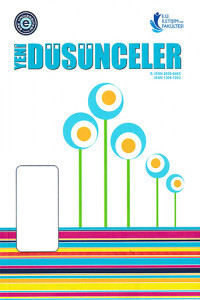BELGESEL FİLM YAPIMINDA YENİ YÖNELİMLER VE MELEZ FORMLAR
Bu makale televizyon ve daha genel
anlamıyla medya sektöründe meydana gelen değişimlerin belgesel film açısından doğurduğu sonuçları irdelemeye çalışmakta
ve son zamanlardaki belgesel türü içinde gözlemlenen melez formların
özelliklerini ve bunlar üzerine yapılan tartışmaları değerlendirmektedir.
Televizyonun ekonomik ve program yapısı ile ilgili öncelikleri, belgesel yapımcılarını
daha çok izleyici kitlesini çekebilecek ve izleyiciyi eğlendirecek yeni arayışlara yönlendirmektedir. Bunun sonucunda da,
bilgi ağırlıklı formlarla kurmacayı bir araya getiren yeni belgesel formlar
ortaya çıkmıştır.
Anahtar Kelimeler:
belgesel film, melez formlar, yeni belgesel
___
- Bondebjerg, Ib (1996). ‘Public Discourse/Private Fascination: Hbyridization in “'true-life-story” Genres’, Media, Culture and Society, 18:27-45.
- Bruzzi, Stella (2000). New Documentary: A Critical Introduction, London: Routledge.
- Carpentier, Nico (2003). ‘The BBC’s Video Nation as a Participatory Media Practice’, International Journal of Cultural Studies, Vol 6(4): 425-447.
- Corner, John (1995). Television Form and Public Address, London: Edward Arnold.
- Corner, J. (1999). Critical Ideas in Television Studies, Oxford: Clarendon Pres
- Corner, J. (2000). ‘Documentary in a Post-Documentary Culture? A Note on Forms and Their Functions’, http://www.lboro.ac.uk/research/changing.media/John%20Corner%20paper .htm
- Corner, J. (2002). ‘Performing the Real: Documentary Diversions’, Television and New Media, Vol.3(3):255-269.
- Dovey, J. (2000). Freakshow: First Person Media and Factual Television, London: Pluto.
- Hampe, B. (1997). Making Documentary Films and Reality Videos, New York: Henry Holt and Company.
- Kilborn, R. (1994). ‘How Real Can You Get? Recent Developments in “Reality” Television’, European Journal of Communication, 9: 421-39.
- Kilborn, R. (1996). ‘New Contexts for Documentary Production in Britain’, Media, Culture and Society, 18: 141-150.
- Kilborn, R. and Izod, J. (1997) An Introduction to Television Documentary, Manchester: Manchester University Press.
- Knight, G. (1989). ‘The Reality Effects of Tabloid Television News’, in Raboy, M. and Bruck, P. A., (eds.), Communication For and Against Democracy, NewYork: Black Rose Books, 111-131.
- Nichols, B. (1991). Representing Reality: Issues and Concepts in Documentary, Bloomington: Indiana University Press.
- Nichols, B. (1994). Blurred Boundaries, Bloomington: Indiana University Press.
- Petley, J. (1996). ‘Fact plus Fiction Equals Friction’, Media, Culture and Society, 18:11-25.
- Rosenthall, A. (1996). Writing, Directing, and Producing Documentary Films and Videos, Carbondale and Edwardsville: Southern Illionois University Press.
- Tracey, M. (1995). ‘Non-Fiction Television’, in Anthony Smith (ed) Television, An International History, Oxford: Oxford University Press.
- Winston, B. (2000) Lies, Damned Lies and Television, London: British Film Institute.
- ISSN: 1306-1003
- Başlangıç: 2017
- Yayıncı: Ege Üniversitesi
Sayıdaki Diğer Makaleler
BELGESEL FİLM YAPIMINDA YENİ YÖNELİMLER VE MELEZ FORMLAR
1980 ÖNCESİ VE SONRASI TÜRK SİNEMASINDA YER ALAN ERKEK KARAKTERİ VE ERKEK İMGESİNDEKİ DEĞİŞİM
FİLM ELEŞTİRİSİNDE ETİK SORUNLAR
VİRİLİO VE “HIZLANDIRILMIŞ HAKİKAT” (Gerçekliğin Yok Oluş Estetiğine İlişkin Bir Deneme)
NEW YORK’TAN NEV ŞEHİR’E ASMALI KONAK
FOTOĞRAF AKIMLARI İÇİNDE GERÇEKLİĞİN SUNUMU
KURUM KİMLİĞİ VE KURUMSAL REKLAM ARASINDAKİ İLİŞKİ
HALKLA İLİŞKİLERİN EVRİMİ: GRUNİG-HUNT MODELLERİ ÜZERİNE BİR ÇALIŞMA
TOPLAM KALİTE HEDEFİNDE MÜŞTERİ MEMNUNİYETİNDEN MÜŞTERİ SADAKATİNE
